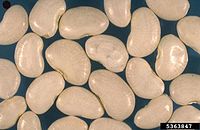
Photo from wikipedia
Peptidoglycan recognition proteins (PGRPs) are a class of molecules that play a critical role in insect immunity. Understanding the function of PGRPs is important to improve the efficiency of microbial… Click to show full abstract
Peptidoglycan recognition proteins (PGRPs) are a class of molecules that play a critical role in insect immunity. Understanding the function of PGRPs is important to improve the efficiency of microbial insecticides. In this study we investigated the role of PGRP-LB (a long type PGRP) in insect immunity against viruses using Spodoptera exigua and Spodoptera exigua multiple nucleopolyhedrovirus (SeMNPV) as an insect-virus model. We cloned and identified a PGRP-LB gene from S. exigua; the gene consisted of seven exons that encoded a polypeptide of 234 amino acids with a signal peptide and a typical amidase domain. Expression analysis revealed the abundance of SePGRP-LB transcripts in the fat body was greater than in other tissues. Overexpression of SePGRP-LB resulted in a significant decrease of 49% in the rate of SeMNPV-infected cells. In addition, the multiplication of SeMNPV was significantly decreased: a decrease of 79% in the production of occlusion-derived virion (ODV), and a maximum decrease of 50% in the production of budded virion (BV). In contrast, silencing of SePGRP-LB expression by RNAi resulted in a significant 1.65-fold increase in the rate of SeMNPV-infected cells, a significant 0.54-fold increase in ODV production, a maximum 1.57-fold increase in BV production, and the larval survival dropped to 21%. Our findings show that SePGRP-LB has an antiviral function against SeMNPV, and therefore this gene may provide a target for lepidopteran pest control using virus insecticides. We cloned and identified a PGRP-LB gene from S. exigua, the gene consisted of seven exons that encoded a polypeptide of 234 amino acids with a signal peptide and a typical amidase domain. Overexpression of SePGRP-LB in S. exigua cells significantly decreased the viral infection rate and production. Silencing SePGRP-LB in S. exigua significantly increased the viral infection rate, viral production, and the lethality of SeMNPV to larvae. SePGRP-LB has antiviral function, opening new opportunities for effective lepidopteran pest control. This article is protected by copyright. All rights reserved.
Journal Title: Insect science
Year Published: 2022
Link to full text (if available)
Share on Social Media: Sign Up to like & get
recommendations!